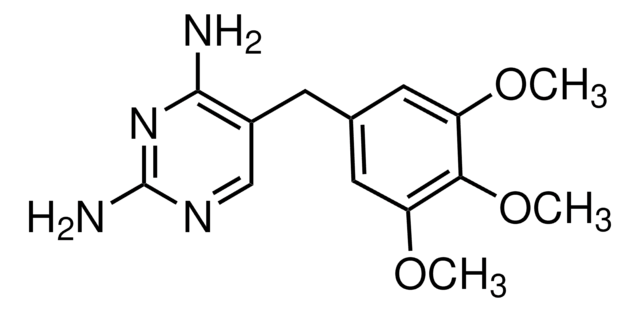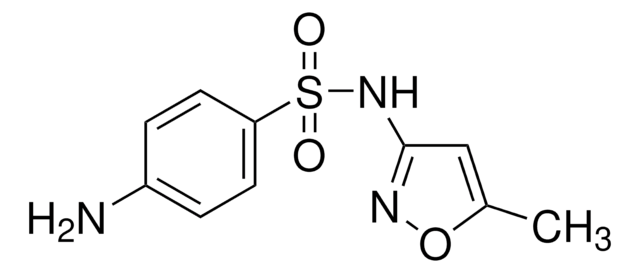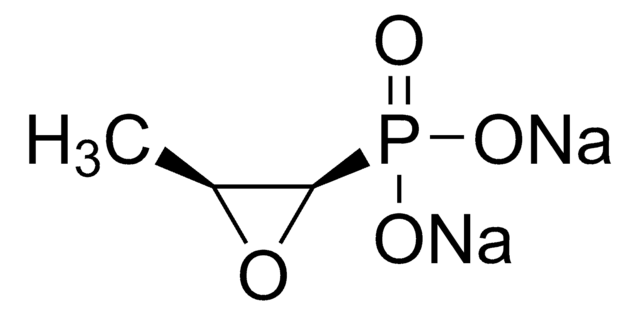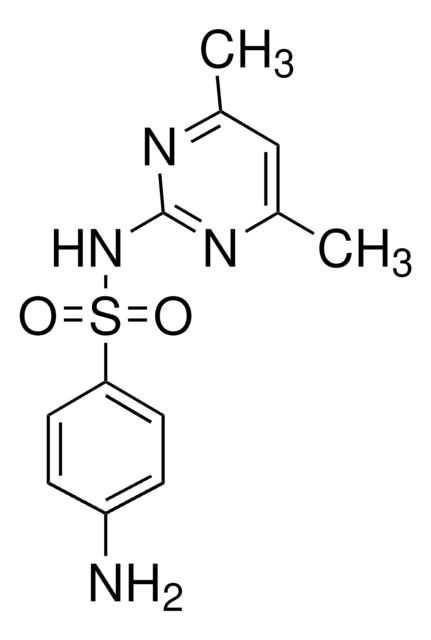92131
Trimetropima
≥99.0% (HPLC)
Sinônimo(s):
2,4-Diamino-5-(3,4,5-trimetoxibenzil)pirimidina, NSC 106568
About This Item
Produtos recomendados
fonte biológica
synthetic
Nível de qualidade
Ensaio
≥99.0% (HPLC)
Formulário
powder
cor
white to light yellow
pf
≥199.0 °C
espectro de atividade do antibiótico
Gram-negative bacteria
Gram-positive bacteria
mycobacteria
Modo de ação
DNA synthesis | interferes
enzyme | inhibits
temperatura de armazenamento
2-8°C
cadeia de caracteres SMILES
COc1cc(Cc2cnc(N)nc2N)cc(OC)c1OC
InChI
1S/C14H18N4O3/c1-19-10-5-8(6-11(20-2)12(10)21-3)4-9-7-17-14(16)18-13(9)15/h5-7H,4H2,1-3H3,(H4,15,16,17,18)
chave InChI
IEDVJHCEMCRBQM-UHFFFAOYSA-N
Informações sobre genes
human ... DHFRP1(573971) , KCNH1(3756)
rat ... Dhfr(24312)
Procurando produtos similares? Visita Guia de comparação de produtos
Descrição geral
Aplicação
Ações bioquímicas/fisiológicas
Embalagem
Outras notas
Palavra indicadora
Warning
Frases de perigo
Declarações de precaução
Classificações de perigo
Acute Tox. 4 Oral - Repr. 2
Código de classe de armazenamento
11 - Combustible Solids
Classe de risco de água (WGK)
WGK 3
Ponto de fulgor (°F)
Not applicable
Ponto de fulgor (°C)
Not applicable
Equipamento de proteção individual
Eyeshields, Gloves, type N95 (US)
Escolha uma das versões mais recentes:
Já possui este produto?
Encontre a documentação dos produtos que você adquiriu recentemente na biblioteca de documentos.
Os clientes também visualizaram
Artigos
This issue of Biofiles reviews some of our newest and most innovative technologies and their specific applications toward cancer research. In preparing this issue of Biofiles, one is reminded how complex the disease of cancer is, and how difficult it is to identify one topic that is completely unrelated to any other.
Nossa equipe de cientistas tem experiência em todas as áreas de pesquisa, incluindo Life Sciences, ciência de materiais, síntese química, cromatografia, química analítica e muitas outras.
Entre em contato com a assistência técnica









